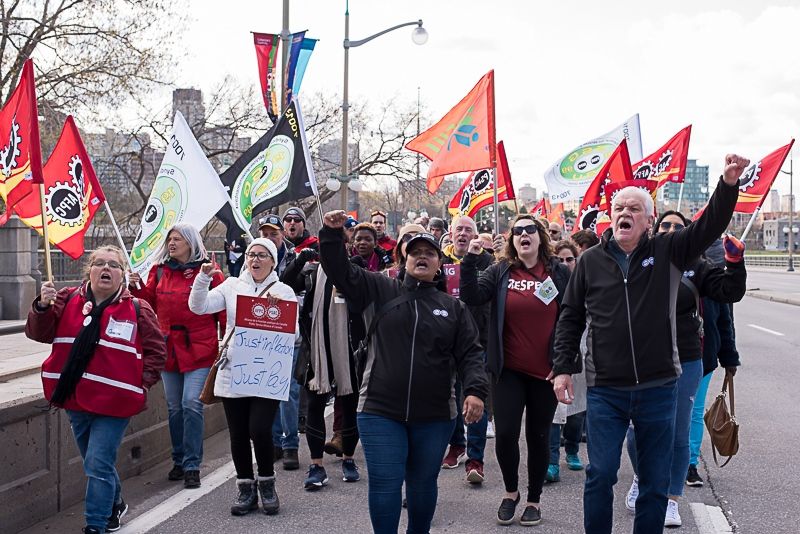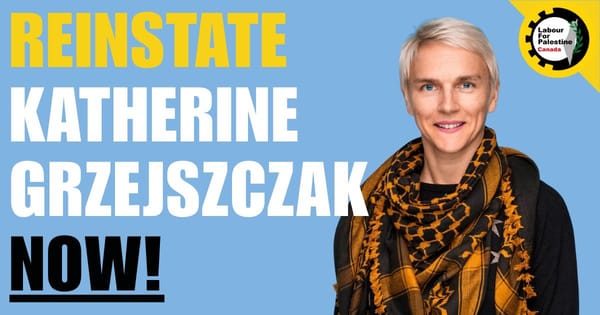
Happy May Day! On this International Workers’ Day, we remain in the midst of the largest public sector strike in Canadian history. The Public Service Alliance of Canada’s (PSAC) 155,000 members are in a pitched battle against their employers in the federal government, the union’s first national-level strike in more than three decades. It is truly something to behold.
For most of these workers, their collective agreements expired nearly two years ago. In bargaining, they’ve faced a government that’s been dragging out negotiations for months on end and has now pushed them onto picket lines across the country. According to PSAC, the employer has even sent emails to some workers encouraging them to continue working. If true, this is especially hypocritical coming from a government that has promised to introduce anti-scab legislation covering the federal private sector by the end of this year.
As many commentators recognize, the outcome of this strike will set the tone for future labour negotiations, in both the public and private sectors. As Armine Yalnizyan puts it: “This PSAC strike is the Big Bang opening in what will be the biggest cascade of negotiations in collective agreements since inflation started scorching paycheques.” All eyes are on PSAC and the government. Unions are hoping for a victory that will embolden labour to demand more at bargaining tables across the country. Employers want the federal government to extinguish this strike before it raises other workers’ expectations.
PSAC demanded 4.5 per cent wage increases in each of the three years of the proposed contract, 2021-23, though the union now claims to have “adjusted” this somewhat at the table, without providing specific details. Much has been made of this 13.5 per cent wage increase, but it’s actually still slightly below the rate of inflation since 2021, which is roughly 13.7 per cent (3.4 per cent in 2021, 6.8 per cent in 2022 and forecasted to be 3.5 per cent in 2023).
Aside from wages, the right to remote work remains a sticking point. The union is seeking to insert a right to negotiate remote work into its collective agreements, which would be a significant victory for labour and could open this possibility to other unions. The employer is predictably opposed and fighting to preserve management’s right to control the conditions of work, including its location.
As much as anti-labour commentators would like to make it so, this strike is not about the direct cost of PSAC’s demands. The Liberals are not running a cash-strapped government with no choice but to be “fiscally prudent.” Rather, we are witnessing an employer that occupies a strategic position in the overall economy attempting to send a message to workers and bosses alike: wage gains must be held in check and workers should expect to continue to shoulder the burden of inflation.
Inflation has been outstripping nominal wage growth and generating a cost-of-living crisis for workers since the beginning of 2021. But recent research from David Macdonald at the Canadian Centre for Policy Alternatives shows that federal public servants have in fact been hit harder than workers in any other industry. While in many industries inflation has driven workers’ real wages back to where they stood before the pandemic, it has been especially damaging to public servants’ real earnings. According to Macdonald’s report, federal public servants, which includes all government employees, not just the PSAC members on strike, are effectively earning what they did in 2007, in inflation-adjusted dollars.
The impact of this wage restraint is not lost on the union. As PSAC put it in a recent bargaining update: “After losing more ground to runaway prices than workers in any other sector for years, the government is now saying Canada’s public service workers should be happy with an offer that leaves them even further behind.”
Despite what many in the mainstream media contend, the union’s wage demands are quite modest, all things considered. Their proposals would likely appear even less ‘radical’ had federal public servants not been forced to accept such small salary increases over the past decade. You have to be sufficiently indoctrinated to think workers wanting their wages to keep pace with inflation is extravagant.
Although unions, overall, have had a difficult time bargaining wage gains in line with inflation, average hourly wages for all employees, union and non-union, have been increasing year-over-year at around 5 per cent for several months now. PSAC’s demands are therefore actually consistent with average wage trends.
Of course, those opposed to the union’s demands will then point to the cost that must be borne by “tax-payers” if public servants get these raises. But what does this cost really amount to?
Arriving at accurate total salary compensation costs for these workers is difficult due to the size of the bargaining units and the range of job classifications and pay grades within them between those who work for the Treasury Board and those who work at the Canada Revenue Agency (CRA). For example, the roughly 120,000 PSAC members who don’t work for the CRA are covered by four separate contracts. The largest grouping — the PA (program and administrative services) group — is nearly 99,000 members. In the last year of the expired contract, 2020, salaries for the dozens of job classifications among this group ranged from an astonishingly low $29,570 to $121,804, though very few public servants earn anywhere close to the latter figure. Most classifications top-out in the $70-80,000 range, many well short of this. Without knowing the job composition of the bargaining unit (i.e., how many people work in each job classification), it’s impossible to know the exact total salary cost.
The union told The Globe and Mail that 60 per cent of their members earn below $70,000, and according to PSAC’s public communications, the average federal public servant’s salary is in the range of $40-$65,000. Using these figures, by my own back-of-the-envelope estimations, which are admittedly crude and constrained by the limited publicly-available information, the cost difference between the union and government proposals is not that great. If we take the midpoint of PSAC’s range — $52,500 — we get a total salary cost for the 155,000 members of around $8.2 billion. Other costs are clearly related to salary, such as pension contributions and overtime premium costs, but let’s put these aside for the moment.
The union is fighting for 4.5 per cent in each of the three years, 2021-23, for the 120,000 workers covered by the four contracts, while the subgroup at the CRA, the Union of Taxation Employees (UTE), is seeking more. The latter’s proposals are more complicated because they are trying to raise entry-level salaries as well. The figure most often quoted in the media is that the UTE increase would amount to 22.5 per cent over the life of the contract.
The government, after initially offering much less, has accepted the recommendations of the Federal Public Sector Labour Relations Board and is now offering 9 per cent over three years to each bargaining group.
The union’s requested salary increases would therefore be in the range of $1.2 billion (roughly $850 million for PSAC salary increases, and $427 million for UTE increases). By contrast, the government’s proposal would represent a total salary increase of around $747 million across both unions. That’s a difference of around $453 million. That may seem like a lot, but keep in mind that over the past years the total “personnel costs” of the federal government have averaged $50.3 billion, with a high-point of $60.7 billion in 2021-22 due to COVID-related program spending.
All this is to say that, even if my quick math is somewhat off the mark, it’s unlikely that the difference between the union’s demands and the government’s position is all that large — certainly not large enough to justify pushing 155,000 workers into a prolonged strike. The Treasury Board and the union obviously have much more accurate figures than these for use in bargaining. The government knows what’s really at stake, and it isn’t their bottom line.
Workers and the labour movement recognize this too. All workers stand to win if PSAC prevails. This is true in the sense that union wages tend to “spill over” and increase the wages of all workers, especially those earning low incomes. But it’s also true because workers are inspired and empowered when they see other workers fight back and win. Governments and employers know this too.
As it stands, the outcome of the strike remains uncertain. Although some progress has apparently been made on non-wage issues at the bargaining table, the sides remain far apart, as far as anyone can tell. Last week, the union moved picket lines to more strategic locations to put further pressure on the government. Finance Minister and Deputy Prime Minister Chrystia Freeland, meanwhile, characterized the Treasury Board’s most recent offer as “very fair” and encouraged union members to accept it.
We know from experience that this is a government unafraid to use back-to-work legislation. At the same time, the Liberals’ agreement with the NDP does impose some limitations, perhaps encouraging the government to think twice about using a heavy-handed approach to ending the dispute. As Stephanie Taylor and Mickey Djuric argue in the Toronto Star, the strike also takes place during a battle for the working-class vote, as the NDP seeks to shore up support among union members while Conservative Party Leader Pierre Poilievre strikes a faux-populist pose — an awkward stance for someone who is, in fact, vehemently anti-union.
The professional commentariat in the mainstream media remains committed to bashing federal public servants and misrepresenting their pay and working conditions. But there’s plenty of evidence that the effectiveness of this anti-union messaging is wearing thin. Greater numbers of people realize that public servants are vital members of our economy and their union is largely made up of modestly-paid members of the working class, not unlike the vast majority of people in this country.
Their fight is our fight. As the old union slogan goes: united we bargain, divided we beg.







